Pheidole flavens
| Pheidole flavens | |
|---|---|

| |
| Scientific classification | |
| Kingdom: | Animalia |
| Phylum: | Arthropoda |
| Class: | Insecta |
| Order: | Hymenoptera |
| Family: | Formicidae |
| Subfamily: | Myrmicinae |
| Tribe: | Attini |
| Genus: | Pheidole |
| Species: | P. flavens |
| Binomial name | |
| Pheidole flavens Roger, 1863 | |
| Subspecies | |
| |
| Synonyms | |
| |
The wide range and abundance of Pheidole flavens is due at least in part to its ability to use different microhabitats as nesting sites. Judging from the extensive data of H. H. Smith (in Forel 1893j) on St. Vincent and J. T. Longino (1997) in Costa Rica, as well as my own collecting records, flavens prefers rotting pieces of wood, but also utilizes spaces beneath the bark of trees, dead knots on tree trunks, sod on rocks, the soil beneath stones, and epiphyte masses. On St. Vincent it occurred (in the early 1890s at least) in forests and thickets from sea level to 900 m, and in Costa Rica it is found today in both wet and dry forests. The nest galleries are diffuse and irregular, the queens hard to find, and mature colonies large, containing up to thousands of workers. Workers collect small arthropods: a captive colony from Trinidad I maintained for over a year eagerly harvested live oribatid mites, and the workers had no difficulty abrading through their hard, smooth exoskeletons. Workers also recruit to sugar baits. (Wilson 2003)
| At a Glance | • Limited invasive |
Identification
See the description in the nomenclature section.
Keys including this Species
Distribution
Pheidole flavens rivals Pheidole jelskii as the most widespread and abundant species of the genus in the New World. Or, put more cautiously, this species or (possibly) this tightly knit group of sibling species I have considered to be the single species flavens has this distinction. It ranges from Florida, where it likely was introduced accidentally by commerce and is relatively uncommon in Dade, Monroe, Collier, and Palm Beach counties (Deyrup, Davis & Cover, 2000.), thence throughout the West Indies, Central America, and most of tropical and subtropical South America as far south as Santa Catarina in Brazil. P. flavens colonies are easily transported by human agency, especially as hitchhikers in nursery stock, as witness the synonymous “var. gracilior” and “var. navigans,” described by Auguste Forel from intercepted live ants in the German quarantine. I collected specimens from a thriving colony in a potted plant from Florida that had been transported to the office of the president of the World Wildlife Fund-U.S. in Washington, D.C. (at first I considered it a new sibling species but have since decided to place it within the broad variation of flavens). Even Forel’s “variety farquharensis” from Madagascar, whose types I have not been able to locate, is almost certainly, if it is truly flavens, to have the same provenance. (Wilson 2003)
Latitudinal Distribution Pattern
Latitudinal Range: 23.133° to -64.36°.
| North Temperate |
North Subtropical |
Tropical | South Subtropical |
South Temperate |
- Source: AntMaps
Distribution based on Regional Taxon Lists
Malagasy Region: Madagascar.
Nearctic Region: United States.
Neotropical Region: Argentina, Bahamas, Barbados, Belize, Brazil, Colombia, Costa Rica, Cuba (type locality), Dominican Republic, Ecuador, Galapagos Islands, Greater Antilles, Grenada, Guadeloupe, Guatemala, Haiti, Honduras, Lesser Antilles, Mexico, Nicaragua, Panama, Paraguay, Peru, Trinidad and Tobago.
Distribution based on AntMaps
Distribution based on AntWeb specimens
Check data from AntWeb
Countries Occupied
| Number of countries occupied by this species based on AntWiki Regional Taxon Lists. In general, fewer countries occupied indicates a narrower range, while more countries indicates a more widespread species. |
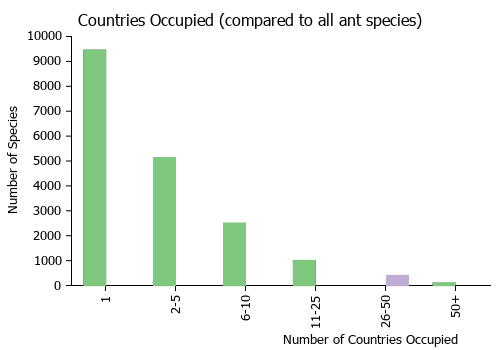
|
Biology
Wheeler (1905), Bahamas - My specimens were taken from several colonies found under stones and in and under old palmetto logs on Andros (Nicholl's Town and Crawl Creek) and on New Providence (Nassau, Fort Charlotte, West Bay) Islands.
Deyrup, Davis & Cover (2000) found this species usually occurred in dry or mesic woods, but can be in a variety of disturbed habitats. Often nests in dry rotten wood. Probably a predator of small arthropods and a scavenger.
Flight Period
| X | |||||||||||
| Jan | Feb | Mar | Apr | May | Jun | Jul | Aug | Sep | Oct | Nov | Dec |
Source: antkeeping.info.
- Check details at Worldwide Ant Nuptial Flights Data, AntNupTracker and AntKeeping.
 Explore: Show all Flight Month data or Search these data. See also a list of all data tables or learn how data is managed.
Explore: Show all Flight Month data or Search these data. See also a list of all data tables or learn how data is managed.
Association with Other Organisms
 Explore: Show all Associate data or Search these data. See also a list of all data tables or learn how data is managed.
Explore: Show all Associate data or Search these data. See also a list of all data tables or learn how data is managed.
This species is a host for the eucharitid wasp Orasema costaricensis (a parasite) (Wheeler & Wheeler, 1937; Kempf, 1972; Baker et al., 2019; Universal Chalcidoidea Database) (primary host).
Castes
Images provided by the Museum of Comparative Zoology and California Academy of Sciences
Worker
Minor
  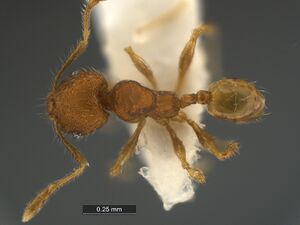 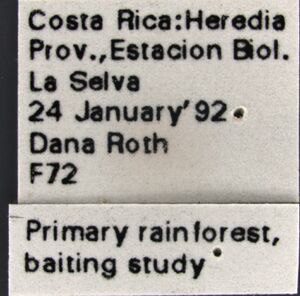     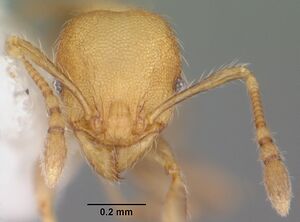   
| |
| . | |
Major
Images from AntWeb
   
| |
| Worker (major/soldier). Specimen code casent0104398. Photographer April Nobile, uploaded by California Academy of Sciences. | Owned by ABS, Lake Placid, FL, USA. |
   
| |
| . | |
   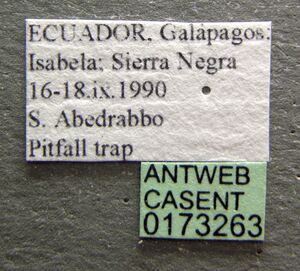
| |
| Worker (major/soldier). Specimen code casent0173263. Photographer April Nobile, uploaded by California Academy of Sciences. | Owned by CDRS, Galapagos, Ecuador. |
   
| |
| Worker (major/soldier). Specimen code casent0178020. Photographer April Nobile, uploaded by California Academy of Sciences. | Owned by ALWC, Alex L. Wild Collection. |
Queen
Images from AntWeb
    
| |
| Queen (alate/dealate). Specimen code casent0104399. Photographer April Nobile, uploaded by California Academy of Sciences. | Owned by ABS, Lake Placid, FL, USA. |
    
| |
| Queen (alate/dealate). Specimen code casent0173262. Photographer April Nobile, uploaded by California Academy of Sciences. | Owned by CDRS, Galapagos, Ecuador. |
   
| |
| Queen (alate/dealate). Specimen code casent0178021. Photographer April Nobile, uploaded by California Academy of Sciences. | Owned by ALWC, Alex L. Wild Collection. |
Nomenclature
The following information is derived from Barry Bolton's Online Catalogue of the Ants of the World.
- flavens. Pheidole flavens Roger, 1863a: 198 (s.w.q.) CUBA. Wheeler, W.M. 1905b: 92 (m.). Senior synonym of aechmeae, gracilior, greggi, haytiana, navigans, spei, tuberculata, vincentensis: Wilson, 2003: 419.
- tuberculata. Pheidole exigua var. tuberculata Mayr, 1887: 585 (s.) BRAZIL. Subspecies of flavens: Emery, 1894c: 157. Junior synonym of flavens: Wilson, 2003: 419.
- vincentensis. Pheidole flavens var. vincentensis Forel, 1893g: 411 (s.w.q.m.) ANTILLES. Junior synonym of flavens: Wilson, 2003: 419.
- gracilior. Pheidole flavens r. gracilior Forel, 1901h: 78 (s.w.q.) GERMANY (intercepted in quarantine, from West Indies). Junior synonym of flavens: Wilson, 2003: 419.
- haytiana. Pheidole flavens var. haytiana Forel, 1907e: 6 (w.) HAITI. Wheeler, W.M. & Mann, 1914: 24 (s.q.m.). Junior synonym of flavens: Wilson, 2003: 419.
- spei. Pheidole flavens st. spei Santschi, 1930e: 77 (s.w.) CUBA. Junior synonym of flavens: Wilson, 2003: 419.
- aechmeae. Pheidole floridana subsp. aechmeae Wheeler, W.M. 1934g: 166 (s.w.) MEXICO. Junior synonym of flavens: Wilson, 2003: 419.
- greggi. Pheidole greggi Naves, 1985: 62, figs. 21, 45, 57 (s.w.) U.S.A. Junior synonym of flavens: Wilson, 2003: 419.
Unless otherwise noted the text for the remainder of this section is reported from the publication that includes the original description.
Description
From Wilson (2003): An extremely abundant, widespread species belonging to a complex of small, yellow, closely similar species that also includes Pheidole asperithorax, Pheidole breviscapa (=Pheidole perpusilla), Pheidole cardiella, Pheidole exigua, Pheidole goeldii, Pheidole kuna, Pheidole mittermeieri, Pheidole moerens, Pheidole nitidicollis, Pheidole nuculiceps, Pheidole pholeops, Pheidole striaticeps and Pheidole trinitatis. P. flavens differs from them in the following combination of traits.
Major: a shallow, relatively indistinct antennal scrobe present, its surface foveolate and opaque; weak rugoreticula often present mesad to the eyes and at the posterior end of the carinulae on the lateral dorsal surface of the head, which are variable in extent and sometimes absent; carinulae along the midline of the dorsum of the head reaching the occipital border but occipital lobes seen in full face view smooth and shiny; humeri usually with a small patch of rugoreticulum; lateral margins of pronotal dorsum also lined with short transverse carinulae; propodeal spine well-developed; postpetiolar node from above roughly trapezoidal; most of dorsal surface of head, all of mesosoma, and sides of waist foveolate and opaque.
Minor: carinulae limited to space mesad to antennal fossa and occasionally also to the frontal lobes and frontal triangle; all of head and mesosoma and sides of waist foveolate and opaque; dorsum of waist and all of gaster smooth and shiny; occiput broad and shallowly concave.
P. flavens is easily confused with P. exiqua and P. moerens, also widespread and abundant species; see the differences under Diagnosis of those species in particular.
MEASUREMENTS (mm) Neotype major: HW 0.72, HL 0.74, SL 0.42, EL 0.08, PW 0.32. Paraneotype minor: HW 0.34, HL 0.42, SL 0.34, EL 0.06, PW 0.24.
COLOR Major and minor: medium to dark yellow.
Figure. Upper: neotype, major. Lower: paraneotype, minor . Scale bars = 1 mm.
Type Material
CUBA: Barrajagua, Las Villas, col. E. O. Wilson. Museum of Comparative Zoology; The neotype was selected after searches in collections containing Roger material failed to turn up the original types. The neotype, from the same country as the Roger type, fits the general concept of flavens held by systematists. (Wilson 2003)
Etymology
L flavens = yellow.
References
- Wilson, E. O. 2003. Pheidole in the New World: A dominant, hyperdiverse ant genus. Harvard University Press, Cambridge, MA.(page 419, fig. major, minor described, Senior synonym of tuberculata, vincentensis, gracilior, navigans, haytiana, spei, aechmeae, greggei)
- Albuquerque, E., Prado, L., Andrade-Silva, J., Siqueira, E., Sampaio, K., Alves, D., Brandão, C., Andrade, P., Feitosa, R., Koch, E., Delabie, J., Fernandes, I., Baccaro, F., Souza, J., Almeida, R., Silva, R. 2021. Ants of the State of Pará, Brazil: a historical and comprehensive dataset of a key biodiversity hotspot in the Amazon Basin. Zootaxa 5001, 1–83 (doi:10.11646/zootaxa.5001.1.1).
- Baker, A.J., Heraty, J.M., Mottern, J., Hang, J.Z., Hines, H.M., Lemmon, A.R., Lemmon, E.M. 2019. Inverse dispersal patterns in a group of ant parasitoids (Hymenoptera: Eucharitidae: Oraseminae) and their ant hosts. Systematic Entomology 45: 1–19 (doi:10.1111/syen.12371).
- Barroso, S.C., Longui, E.L., Fernandes, T.T., Oliveira, C.M., Ferreira, A.C., Silva, R.R., Morini, M.S.C. 2020. Twigs occupied by Pheidole Westwood, 1839: Is there a difference between species? Biota Neotropica 20: e20190897 (doi:10.1590/1676-0611-BN-2019-0897).
- Bulter, I. 2020. Hybridization in ants. Ph.D. thesis, Rockefeller University.
- Deyrup, M., Davis, L. & Cover, S. 2000. Exotic ants in Florida. Transactions of the American Entomological Society 126, 293-325.
- Deyrup, M.A., Carlin, N., Trager, J., Umphrey, G. 1988. A review of the ants of the Florida Keys. Florida Entomologist 71: 163-176.
- Forel, A. 1893. Formicides de l’Antille St. Vincent, récoltés par Mons. H. H. Smith. Trans. Entomol. Soc. Lond. 1893: 333–418.
- Franco, W., Ladino, N., Delabie, J.H.C., Dejean, A., Orivel, J., Fichaux, M., Groc, S., Leponce, M., Feitosa, R.M. 2019. First checklist of the ants (Hymenoptera: Formicidae) of French Guiana. Zootaxa 4674, 509–543 (doi:10.11646/zootaxa.4674.5.2).
- Guillem, R., Bensusan, K. 2022. Thee new exotic species of ants (Hymenoptera, Formicidae) for Madeira, with comments on its myrmecofauna. Journal of Hymenoptera Research 91: 321–333 (doi:10.3897/jhr.91.81624).
- Herrera, H.W., Baert, L., Dekoninck, W., Causton, C.E., Sevilla, C.R., Pozo, P., Hendrickx, F. 2020. Distribution and habitat preferences of Galápagos ants (Hymenoptera: Formicidae). Belgian Journal of Entomology, 93: 1–60.
- Lubertazzi, D. 2019. The ants of Hispaniola. Bulletin of the Museum of Comparative Zoology, 162(2), 59-210 (doi:10.3099/mcz-43.1).
- Meurgey, F. 2020. Challenging the Wallacean shortfall: A total assessment of insect diversity on Guadeloupe (French West Indies), a checklist and bibliography. Insecta Mundi 786: 1–183.
- Roger, J. 1863a. Die neu aufgeführten Gattungen und Arten meines Formiciden-Verzeichnisses nebst Ergänzung einiger früher gegebenen Beschreibungen. Berl. Entomol. Z. 7: 131-214 (page 198, soldier, worker, queen described)
- Sarnat, E. M., G. Fischer, B. Guenard, and E. P. Economo. 2015. Introduced Pheidole of the world: taxonomy, biology and distribution. Zookeys. 1-109. doi:10.3897/zookeys.543.6050
- Wetterer, J.K. 2021. Ants (Hymenoptera, Formicidae) of St. Vincent, West Indies. Sociobiology 68, e6725 (doi:10.13102/sociobiology.v68i2.6725).
- Wheeler, W. M. 1905c. The ants of the Bahamas, with a list of the known West Indian species. Bull. Am. Mus. Nat. Hist. 21: 79-135 (page 92, male described)
References based on Global Ant Biodiversity Informatics
- Adams B. J., S. A. Schnitzer, and S. P. Yanoviak. 2019. Connectivity explains local ant community structure in a Neotropical forest canopy: a large-scale experimental approach. Ecology 100(6): e02673.
- Adams, R.M.M. and J.T. Longino. 2007. Nesting biology of the arboreal fungus-growing ant Cyphomyrmex cornutus and behavioral interactions with the social-parasitic ant Megalomyrmex mondabora. Insectes Sociaux 54:136-143
- Alayo D. P. 1974. Introduccion al estudio de los Himenopteros de Cuba. Superfamilia Formicoidea. Academia de Ciencias de Cuba. Instituto de Zoologia. Serie Biologica no.53: 58 pp. La Habana.
- Antoniazzi R., R. N. S. L. Garoo, W. Dattilo, S. P. Ribeiro, and F. S. Neves. 2019. Ant species richness and interactions in canopies of two distinct successional stages in a tropical dry forest. The Science of Nature 106: 20
- Araujo Castilho G., F. Barbosa Noll, E. R. da Silva, and E. F. dos Santos. 2011. Diversidade de Formicidae (Hymenoptera) em um fragmento de Floresta Estacional Semidecídua no Noroeste do estado de São Paulo, Brasil. R. bras. Bioci., Porto Alegre 9(2): 224-230.
- Brandao, C.R.F. 1991. Adendos ao catalogo abreviado das formigas da regiao neotropical (Hymenoptera: Formicidae). Rev. Bras. Entomol. 35: 319-412.
- Branstetter M. G. and L. Sáenz. 2012. Las hormigas (Hymenoptera: Formicidae) de Guatemala. Pp. 221-268 in: Cano E. B. and J. C. Schuster. (eds.) 2012. Biodiversidad de Guatemala. Volumen 2. Guatemala: Universidad del Valle de Guatemala, iv + 328 pp
- Calcaterra L. A., F. Cuezzo, S. M. Cabrera, and J. A. Briano. 2010. Ground ant diversity (Hymenoptera: Formicidae) in the Ibera nature reserve, the largest wetland of Argentina. Ann. Entomol. Soc. Am. 103(1): 71-83.
- Castano-Meneses, G., M. Vasquez-Bolanos, J. L. Navarrete-Heredia, G. A. Quiroz-Rocha, and I. Alcala-Martinez. 2015. Avances de Formicidae de Mexico. Universidad Nacional Autonoma de Mexico.
- Culver D. C. 1974. Species packing in Caribbean and North Temperate ant communities. Ecology 55(5): 974-988.
- Dattilo W. et al. 2019. MEXICO ANTS: incidence and abundance along the Nearctic-Neotropical interface. Ecology https://doi.org/10.1002/ecy.2944
- De la Mora, A., J. A. Garcia-Ballinas, and S. M. Philpott. 2015. Local, landscape, and diversity drivers of predation services provided by ants in a coffee landscape in Chiapas, Mexico. Agriculture, Ecosystems & Environment 201: 83-91.
- Deyrup M., L. Davis, and S. Buckner. 1998. Composition of the ant fauna of three Bahamian islands. Proceedings of the seventh symposium on the natural history of the Bahamas. 23-32. Bahamian Field Station, San Salvador, Bahamas
- Donoso D. A. 2014. Assembly mechanisms shaping tropical litter ant communities. Ecography 37 doi: 10.1111/j.1600-0587.2013.00253.x
- Emery C. 1894. Studi sulle formiche della fauna neotropica. VI-XVI. Bullettino della Società Entomologica Italiana 26: 137-241.
- Escalante Gutiérrez J. A. 1993. Especies de hormigas conocidas del Perú (Hymenoptera: Formicidae). Revista Peruana de Entomología 34:1-13.
- Favretto M. A., E. Bortolon dos Santos, and C. J. Geuster. 2013. Entomofauna from West of Santa Catarina State, South of Brazil. EntomoBrasilis 6 (1): 42-63.
- Fernandes I., and J. de Souza. 2018. Dataset of long-term monitoring of ground-dwelling ants (Hymenoptera: Formicidae) in the influence areas of a hydroelectric power plant on the Madeira River in the Amazon Basin. Biodiversity Data Journal 6: e24375.
- Fernandes T. T., R. R. Silva, D. Rodrigues de Souza-Campana, O. Guilherme Morais da Silva, and M. Santina de Castro Morini. 2019. Winged ants (Hymenoptera: Formicidae) presence in twigs on the leaf litter of Atlantic Forest. Biota Neotropica 19(3): http://dx.doi.org/10.1590/1676-0611-bn-2018-0694
- Fernandes T. T., W. Dattilo, R. R. Silva, P. Luna, C. M. Oliveira, and M. Santina de Castro Morini. 2019. Ant occupation of twigs in the leaf litter of the Atlantic Forest: influence of the environment and external twig structure. Tropical Conservation Science 12: 1-9.
- Fernández Triana J. L., J. L. Fontenla, E. Portuondo Ferrer, and J. A. Genaro. 2005. Especies de himenópteros registrados en el Parque Nacional La Bayamesa, Cuba, 17-22 de junio del 2003 y 2-10 de febrero del 2004. In Maceira F., D., A.Fong G., W. S. Alverson, y/and T. Wachter, eds. 2005. Cuba: Parque Nacional La Bayamesa. Rapid Biological Inventories Report 13. The Field Museum, Chicago.
- Fernández, F. and S. Sendoya. 2004. Lista de las hormigas neotropicales. Biota Colombiana Volume 5, Number 1.
- Fontanla Rizo J.L. 1997. Lista preliminar de las hormigas de Cuba. Cocuyo 6: 18-21.
- Fontenla J. L., and J. Alfonso-Simonetti. 2018. Classification of Cuban ants (Hymenoptera: Formicidae) into functional groups. Poeyana Revista Cubana de Zoologia 506: 21-30.
- Fontenla Rizo J. L. 1993. Composición y estructura de comunidades de hormigas en un sistema de formaciones vegetales costeras. Poeyana. Instituto de Ecología y Sistemática, Academia de Ciencias de Cuba 441: 1-19.
- Fontenla Rizo J. L. 1993. Mirmecofauna de Isla de la Juventud y de algunos cayos del archipielago cubano. Poeyana. Instituto de Ecologia y Sistematica, Academia de Ciencias de Cuba 444:1-7.
- Fontenla Rizo J. L. 1997. Lista preliminar de las hormigas de Cuba (Hymenoptera: Formicidae). Cocuyo 6: 18-21.
- Forel A. 1901. Formiciden des Naturhistorischen Museums zu Hamburg. Neue Calyptomyrmex-, Dacryon-, Podomyrma- und Echinopla-Arten. Mitt. Naturhist. Mus. Hambg. 18: 43-82.
- Forel A. 1901. Variétés myrmécologiques. Annales de la Société Entomologique de Belgique 45: 334-382.
- Forel A. 1907. Formiciden aus dem Naturhistorischen Museum in Hamburg. II. Teil. Neueingänge seit 1900. Mitt. Naturhist. Mus. Hambg. 24: 1-20.
- Forel A. 1908. Catálogo systemático da collecção de formigas do Ceará. Boletim do Museu Rocha 1(1): 62-69.
- Forel A. 1908. Fourmis de Costa-Rica récoltées par M. Paul Biolley. Bulletin de la Société Vaudoise des Sciences Naturelles 44: 35-72.
- Forel A. 1913. Fourmis d'Argentine, du Brésil, du Guatémala & de Cuba reçues de M. M. Bruch, Prof. v. Ihering, Mlle Baez, M. Peper et M. Rovereto. Bulletin de la Société Vaudoise des Sciences Naturelles. 49: 203-250.
- Franco W., N. Ladino, J. H. C. Delabie, A. Dejean, J. Orivel, M. Fichaux, S. Groc, M. Leponce, and R. M. Feitosa. 2019. First checklist of the ants (Hymenoptera: Formicidae) of French Guiana. Zootaxa 4674(5): 509-543.
- Galkowski C. 2016. New data on the ants from the Guadeloupe (Hymenoptera, Formicidae). Bull. Soc. Linn. Bordeaux 151, 44(1): 25-36.
- Gomez V. E. S., and G. Z. González. 2007. Catalogo de Las Hormigas Presentes en El Museo de Historia Natural de la Universidad del Cauca. Popayán : 1-58.
- Gregg R. E. 1959. Key to the species of Pheidole (Hymenoptera: Formicidae) in the United States. Journal of the New York Entomological Society 66: 7-48.
- Kempf, W.W. 1972. Catalago abreviado das formigas da regiao Neotropical (Hym. Formicidae) Studia Entomologica 15(1-4).
- Kusnezov N. 1952. El género Pheidole en la Argentina (Hymenoptera, Formicidae). Acta Zoologica Lilloana 12: 5-88.
- Kusnezov N. 1978. Hormigas argentinas: clave para su identificación. Miscelánea. Instituto Miguel Lillo 61:1-147 + 28 pl.
- LaPolla, J.S. and S.P. Cover. 2005. New species of Pheidole (Hymenoptera: Formicidae) from Guyana, with a list of species known from the country. Tranactions of the American Entomological Society 131(3-4):365-374
- Lapolla, J. S., and S. P. Cover. "New species of Pheidole (Hymenoptera : Formicidae) from Guyana, with a list of species known from the country." Transactions of the American Entomological Society 131, no. 3-4 (2005): 365-374.
- Lapolla, J.S., T. Suman, J. Soso-Calvo and T.R. Schultz. 2006. Leaf litter ant diversity in Guyana. Biodiversity and Conservation 16:491510
- Leponce M., J. H. C. Delabie, J. Orivel, J. Jacquemin, M. Calvo Martin, and A. Dejean. 2019. Tree-dwelling ant survey (Hymenoptera, Formicidae) in Mitaraka, French Guiana, in Touroult J. (ed.), “Our Planet Reviewed” 2015 large-scale biotic survey in Mitaraka, French Guiana. Zoosystema 41 (10): 163-179.
- Longino J. T. L., and M. G. Branstetter. 2018. The truncated bell: an enigmatic but pervasive elevational diversity pattern in Middle American ants. Ecography 41: 1-12.
- Longino J. T., and R. K. Colwell. 2011. Density compensation, species composition, and richness of ants on a neotropical elevational gradient. Ecosphere 2(3): 16pp.
- Longino J. et al. ADMAC project. Accessed on March 24th 2017 at https://sites.google.com/site/admacsite/
- Macedo-Reis L. E., A. C. Leite, T. J. Guerra, R. Antoniazzi, and F. Neves. Suspended leaf litter in an understorey treelet as habitat extension for ground-dwelling ants in the Atlantic Forest, south-eastern Brazil. Journal of Tropical Ecology https://doi.org/10.1017/S0266467419000154
- Mann W. M. 1920. Additions to the ant fauna of the West Indies and Central America. Bulletin of the American Museum of Natural History 42: 403-439.
- McGlynn, T.P. and J.P. Owen. 2002. Food supplementation alters caste allocation in a natural population of Pheidole flavens, a dimorphic leaf-litter dwelling ant. Insectes Sociaux 49:8-14
- Menozzi C, Russo G. 1930. Contributo alla conoscenza della mirmecofauna della Repubblica Dominicana (Antille). Bollettino del Laboratorio di Zoologia Generale e Agraria della Reale Scuola Superiore d'Agricoltura. Portici. 24: 148-173.
- Menozzi C. 1927. Formiche raccolte dal Sig. H. Schmidt nei dintorni di San José di Costa Rica. Entomologische Mitteilungen. Berlin-Dahlem. 16: 266-277.
- Milks, M.L., J.R. Fuxa, A.R. Richter and E.B. Moser. 2007. Multivariate analyses of the factors affecting the distribution, abundance and social form of Louisiana fire ants, Solenopsis invicta. Insectes Sociaux 54:283-292
- Morrison L. W. 1998. A review of Bahamian ant (Hymenoptera: Formicidae) biogeography. Journal of Biogeography 25: 561-571.
- Morrison, Lloyd. 2006. The Ants of Small Bahamian Cays. Bahamas Naturalist & Journal of Science. 1(2):27-32.
- Perez-Gelabert D. E. 2008. Arthropods of Hispaniola (Dominican Republic and Haiti): A checklist and bibliography. Zootaxa 1831:1-530.
- Pires de Prado L., R. M. Feitosa, S. Pinzon Triana, J. A. Munoz Gutierrez, G. X. Rousseau, R. Alves Silva, G. M. Siqueira, C. L. Caldas dos Santos, F. Veras Silva, T. Sanches Ranzani da Silva, A. Casadei-Ferreira, R. Rosa da Silva, and J. Andrade-Silva. 2019. An overview of the ant fauna (Hymenoptera: Formicidae) of the state of Maranhao, Brazil. Pap. Avulsos Zool. 59: e20195938.
- Portuondo E. F., and J. L. Reyes. 2002. Mirmecofauna de los macizos montañosos de Sierra Maestra y Nipe-Sagua-Baracoa. Cocuyo 12: 10-13
- Portuondo E. F., and J. L. Reyes. 2006. Species of hymenopterans recorded in Siboney-Juticí Ecological Reserve, Santiago de Cuba Province, compiled from collections during the rapid inventory of 27-28 September 2002. Fong G., A., D. Maceira F., W. S. Alverson, y / and J. M. Shopland, eds. 2005. Cuba: Siboney-Juticí. Rapid Biological Inventories Report 10. The Field Museum, Chicago.
- Portuondo Ferrer E., and J. L. Fernández Triana. 2005. Species of hymenopterans (bees, wasps, and ants) recorded in Alejandro de Humboldt National Park, from literature records, revision of the collection at BIOECO, and collections before and during the rapid inventory, 12-22 February 2004. In Fong G., A., D. Maceira F., W. S. Alverson, y/and T. Wachter, eds. 2005. Cuba: Parque Nacional Alejandro de Humboldt. Rapid Biological Inventories Report 14. The Field Museum, Chicago.
- Portuondo Ferrer, E. and J. Fernandez Triana. Biodiversidad del orden Hymenoptera en Los Macizos Montanosos de Cuba Oriental. Boletin S.E.A. 35:121-136.
- Ramirez M., J. Montoya-Lerma, and I. Armbrecht. 2010. Fodder banks: Does cyclic pruning influence soil ant richness (Hymenoptera: Formicidae)? AVANCES EN INVESTIGACIÓN AGROPECUARIA 13(3): 47-66.
- Rosa da Silva R. 1999. Formigas (Hymenoptera: Formicidae) do oeste de Santa Catarina: historico das coletas e lista atualizada das especies do Estado de Santa Catarina. Biotemas 12(2): 75-100.
- Sandoval V. E., and G. Zambrano. 2007. Catálogo de las hormigas presentes en el Museo de Historia Natural de la Universidad del Cauca. Taller Editorial de la Universidad del Cauca, Popayán. 60 pp.
- Santschi F. 1925. Fourmis des provinces argentines de Santa Fe, Catamarca, Santa Cruz, Córdoba et Los Andes. Comunicaciones del Museo Nacional de Historia Natural "Bernardino Rivadavia" 2: 149-168.
- Santschi F. 1930. Quelques fourmis de Cuba et du Brésil. Bulletin. Société Entomologique d'Egypte. 14: 75-83.
- Santschi F. 1933. Fourmis de la République Argentine en particulier du territoire de Misiones. Anales de la Sociedad Cientifica Argentina. 116: 105-124.
- Smith M. A., W. Hallwachs, D. H. Janzen. 2014. Diversity and phylogenetic community structure of ants along a Costa Rican elevational gradient. Ecography 37(8): 720-731.
- Smith, Marion R. 1954. American Museum Novitates. Ants of the Bimini Island Group, Bahamas, British West Indies (Hymenoptera, Formicidae). 1671:1-16
- Smith, Marion R. 1954. Ants of the Bimini Island Group, Bahamas, British West Indies. American Museum of Natural History. 1671. 1-16.
- Ulyssea M.A., C. E. Cereto, F. B. Rosumek, R. R. Silva, and B. C. Lopes. 2011. Updated list of ant species (Hymenoptera, Formicidae) recorded in Santa Catarina State, southern Brazil, with a discussion of research advances and priorities. Revista Brasileira de Entomologia 55(4): 603-611.
- Vásquez-Bolaños M. 2011. Lista de especies de hormigas (Hymenoptera: Formicidae) para México. Dugesiana 18: 95-133
- Wheeler W. M. 1905. The ants of the Bahamas, with a list of the known West Indian species. Bulletin of the American Museum of Natural History 21: 79-135.
- Wheeler W. M. 1913. The ants of Cuba. Bulletin of the Museum of Comparative Zoology 54: 477-505.
- Wheeler W. M. 1917. Jamaican ants collected by Prof. C. T. Brues. Bulletin of the Museum of Comparative Zoology 61: 457-471.
- Wheeler W. M. 1922. Ants of the American Museum Congo expedition. A contribution to the myrmecology of Africa. IX. A synonymic list of the ants of the Malagasy region. Bulletin of the American Museum of Natural History 45: 1005-1055
- Wheeler W. M. 1922. The ants of Trinidad. American Museum Novitates 45: 1-16.
- Wheeler W. M. 1925. Neotropical ants in the collections of the Royal Museum of Stockholm. Arkiv för Zoologi 17A(8): 1-55.
- Wheeler W. M. 1934. Neotropical ants collected by Dr. Elisabeth Skwarra and others. Bulletin of the Museum of Comparative Zoology 77: 157-240.
- Wheeler W. M., and W. M. Mann. 1914. The ants of Haiti. Bulletin of the American Museum of Natural History 33: 1-61.
- Wheeler, William Morton. 1911. Additions to the Ant-Fauna of Jamaica. Bulletin American Museum of Natural History. 30:21-29.
- Wheeler, William Morton. 1934. Some Ants From The Bahama Islands. Psyche. 41(4):230-232.
- Wilson, E.O. 2003. Pheidole in the New World: A Dominant, Hyperdiverse Genus. Harvard University Press
- Zolessi L. C. de, Y. P. Abenante, and M. E. de Philippi. 1988. Lista sistematica de las especies de Formicidos del Uruguay. Comun. Zool. Mus. Hist. Nat. Montev. 11: 1-9.
- Zolessi L. C. de; Y. P. de Abenante, and M. E. Philippi. 1989. Catálogo sistemático de las especies de Formícidos del Uruguay (Hymenoptera: Formicidae). Montevideo: ORCYT Unesco, 40 + ix pp.
- de Zolessi, L.C., Y.P. de Abenante and M.E. Phillipi. 1989. Catalago Systematico de las Especies de Formicidos del Uruguay (Hymenoptera: Formicidae). Oficina Regional de Ciencia y Technologia de la Unesco para America Latina y el Caribe- ORCYT. Montevideo, Uruguay


